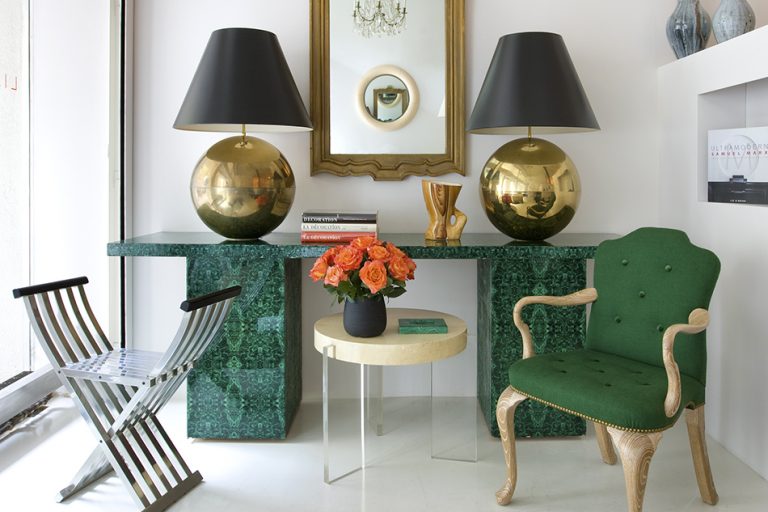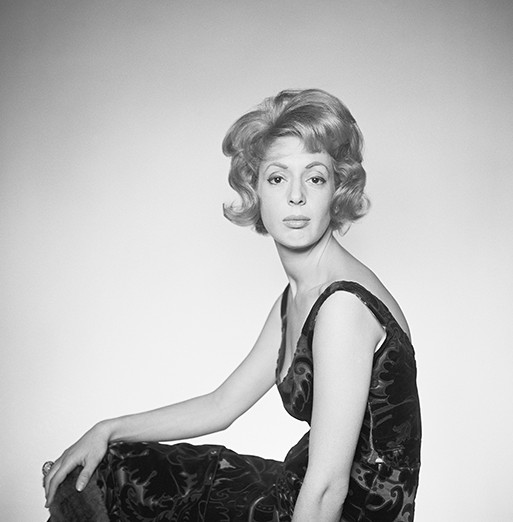
May 9, 2012Liz O’Brien — the inimitable mid-century design dealer and, now, furniture designer — will show her “Editions” collection of chairs, sofas, tables, lamps and more at the 1stdibs’ showroom on the 10th floor of the NYDC from May 9 through June 4. All photos courtesy of Liz O’Brien; Top: The window of O’Brien’s light-filled 61st Street shop is an ever-rotating display, one that mixes her own designs (a malachite paper-wrapped console table and a green-upholstered Frances dining chair) with such modernist gems as a Samuel Marx Lucite table and a pair of brass ball lamps by Karl Springer.
Everyone likes Liz O’Brien. They really, really like her. In that sense, the New York 20th-century design dealer is an anomaly in her field of endeavor — one where intramural grievances, grudges and sniping are all too common. It’s not only O’Brien’s subdued personal elegance and quiet, warm demeanor that win her such esteem (she’s neither a gossip, nor one of those shrieking “Oh, my God! That’s fabulous!” types) but also her graceful taste and thorough knowledge of the world of modern design, as well as her generosity in sharing that knowledge, even with those also in the business.
“Liz’s shop was where I was exposed to the softer, more glamorous side of modernism,” says Patrick Parrish, principal of the downtown Manhattan gallery Mondo Cane. “I had the hard-edge part down pat, but I remember going into her first store, in Soho, [where O’Brien entered the business in 1993; she’s now located on the Upper East Side] and experiencing amazing pieces I had never seen before; pieces that were modern but not severe. Because of her, I discovered that modernism is about much more than just Charles and Ray Eames and George Nelson. It’s also about Samuel Marx, James Mont, John Dickinson and Billy Haines, just to mention a few of the big names she was the first to expose me to.”
Although she’d wanted to express herself in a furniture collection of her own design for some time, O’Brien — who is the furthest thing from self-promotional — hesitated for several years. And then, last fall, given new confidence in her charismatic tastes by her business partner, Michael Raynes, she launched “Liz O’Brien Editions,” which will be the focus of a month-long exhibition starting May 9 at the 1stdibs showroom on the 10th floor of the New York Design Center, at 200 Lexington Avenue.

The Frances dining chair, available upholstered in a broad palette of couture colors, was inspired in equal parts by Frances Elkins, Yves Saint Laurent and Ladurée macarons.
1. How would you describe your aesthetic?
Modern, but grounded in history. Designers like Samuel Marx and Frances Elkins have had a huge influence on the way I see things. They didn’t try to reinvent the wheel. They tweaked historical models and made them right for modern living. I feel a particular kinship with Marx. He trained at the École des Beaux-Arts in Paris, but he wasn’t interested in looks. Instead, he cared about what works in design — not what was stylish but what was relevant.
2. As a dealer and, now, a designer, do you follow your instincts or do you try to predict the movement of the market?
Ha! For better or worse, I’ve pretty much stuck to my own instincts. Luckily for me, I continue to discover things that keep me excited and engaged. And just as luckily, I have a group of clients that share my tastes and trust my instincts. It reminds me in a way of when I decided to get into this business. I was making my first visit to the flea market in Paris, and I saw not only these crazy, quirky dealers but also the buyers whose interests were clearly idiosyncratic and wide-ranging. I thought, “I have found my tribe.”
3. Several dealers, such as Paul Donzella and Patrick Parrish, have told me how much they learned from you. But, of course, they are members of “the tribe.” How is it with customers who wander in off the street and likely aren’t — immediately, at least — going to buy anything? Annoying?
Not at all. You know, I could talk about furniture all day. I’m happy to educate people who are collectors, or may become collectors down the road. Actually, I’m surprised that more young people don’t come in just to learn about design history and things like finishes, and how to identify what’s significant and find out why it’s significant. I think there are many dealers like me who love to share what we know.

October, 2011, marked the launch of “Liz O’Brien Editions,” pieces from which are now regularly on display amid the mid-century antiques in the dealer’s 3,000-square-foot Upper East Side gallery.

The raspberry hue and subtle curves of O’Brien’s linen-upholstered Pamela settee pop against a lavender wall. The pair of Albert mirrors, edged in fabric-wrapped frames, are also from O’Brien’s new collection.
4. Would you say every aspect of the world of design is incremental, from dealing to collecting?
Absolutely. When I opened my first store I centered on the 1930s and ’40s, which were dismissed — everyone was looking at the ’50s. When I became deeply engaged with the work of Sam Marx, I had to track down original clients to identify his work. That, and I assembled a huge group of old decorating magazines to learn about him. I still see myself as an antiques dealer, but now that I have the “Editions” collection, it’s great to display both vintage and new material in the gallery so the two can be seen in context with each other.
5. What are your goals and aims with “Liz O’Brien Editions”?
We’re trying to keep to really simple forms, while experimenting with fabrics and patterns. Over the years, to my eye, there have been models and techniques that stand out as the “keepers.” It’s so much fun to play off the work of designers I admire. The elegance of Sam Marx; the fabric-wrapped furniture technique from the ’70s that I used for the Albert occasional table — that’s inspired by Albert Hadley, of course — or the femininity of Frances Elkins’ pieces and the manlier chic of Billy Haines chairs. I was moved by them all. I want to tease out the best of the best and present them all in an updated way with of-the-moment finishes and materials.


